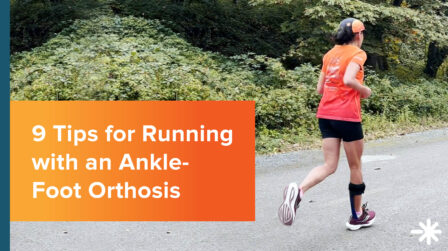Tips for a Safe Winter with Your Lower Limb Prosthesis

Winter is upon us. If you live in areas with ice and freezing temperatures, navigating these conditions can be challenging, especially if you use a lower limb prosthesis. Here are seven tips to help you stay safe this winter.
Winter Safety Tips
1. Be Aware of Weather Conditions
Staying aware of weather changes is your first line of defense. This can help you appropriately prepare for elements you may encounter while outdoors. Additionally, different weather conditions may result in different snow environments. For example, on slick, tightly packed snow, you may need to carefully distribute your weight between heel and toe and use additional traction devices to keep a good, firm base beneath your feet for balance. In deep snow, you may need to lift your legs with each step to avoid a fall.
2. Be Cautious on Slippery and Treated Surfaces
One of the biggest winter hazards is unsafe walking conditions. Snow and ice make surfaces slippery, increasing the risk of falling. Additionally, if a surface has been treated with sand or salt to remove the snow and ice, it can cause instability and throw off your balance. Be sure to assess walking paths and proceed slowly.
3. Use Appropriate Winter Footwear and Clothing
It is important to wear appropriate footwear with traction. Consider slip-on cleats or grips for shoes, cleats for prostheses, and spiked bottoms for canes or crutches.
Often, we wear boots on cold winter days, which may have thicker soles than traditional shoes. If your alignment feels off or you experience pain or balance issues with this change in footwear, contact your prosthetist.
Be sure to wear layers of clothing to keep your body warm. Take caution with any additional clothing that could cause you to trip.
4. Use Supportive Devices When Needed
While you may have confidence walking and moving with your prosthesis during optimal weather conditions, using an assistive device during poor weather conditions can help prevent a fall. It may be beneficial to use a cane, crutch, walker, or walking sticks for added balance and stabilization.
Additionally, use handrails or help from family and friends when available. If you typically carry a purse or tote, consider a backpack or crossbody style to free up your hands for balance and safety.
5. Stay Warm During Cold Temperatures
Just as heat can cause swelling in the summer, cold temperatures can cause limb shrinkage in the winter. Staying warm in winter can help keep your prosthesis fitting its best. If you do notice limb shrinkage, consider adjusting or adding sock ply as needed.
Additionally, cold temperatures can cause increased stiffness and pain, which may alter your comfort and range of motion and increase the possibility of a fall.
6. Know What to Do If You Fall
It is important to learn the best and safest way to recover on your own from an unexpected fall. If you fall, assess yourself for any pain, then roll onto your stomach and use your hands and forearms to support yourself to a standing position. Also, be sure to charge your cell phone and have it with you in case you need assistance.
7. Keep Outdoor Areas Clear of Snow and Ice
At home and on the go, inspect walkways, steps, hills, and ramps before walking on them. If needed, get help clearing your walkway area at home. If a pathway looks dangerous, consider selecting an alternative route.
While it is important to take caution, we also encourage you to enjoy the winter activities you love. If you have any questions about participating in winter activities with your prosthesis, please reach out to your local Hanger Clinic prosthetist.
Request a Free Evaluation
If you or someone you love is looking for personalized prosthetic care, get in touch with a board-certified prosthetist at a Hanger Clinic near you.
Latest Updates
Subscribe to stay up-to-date on our latest posts.



